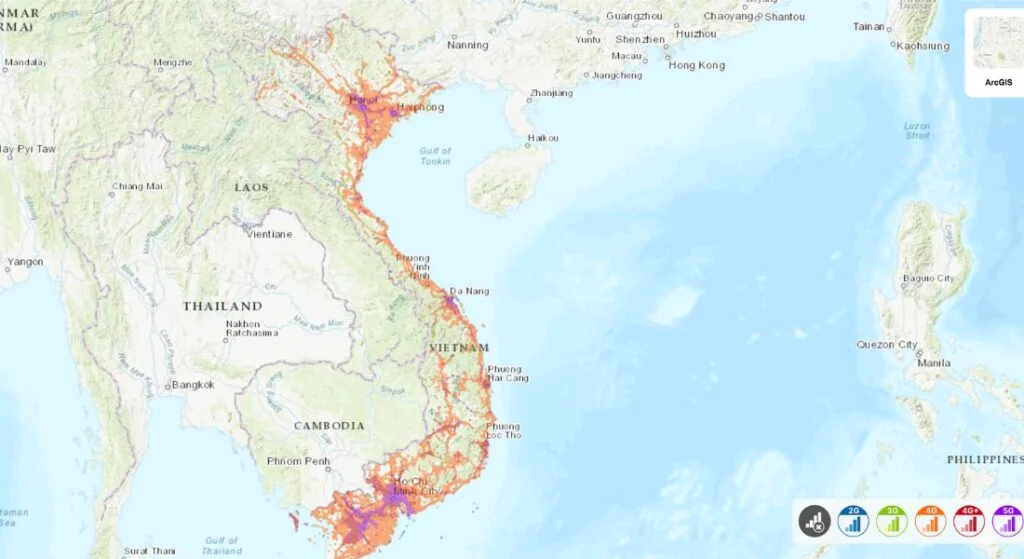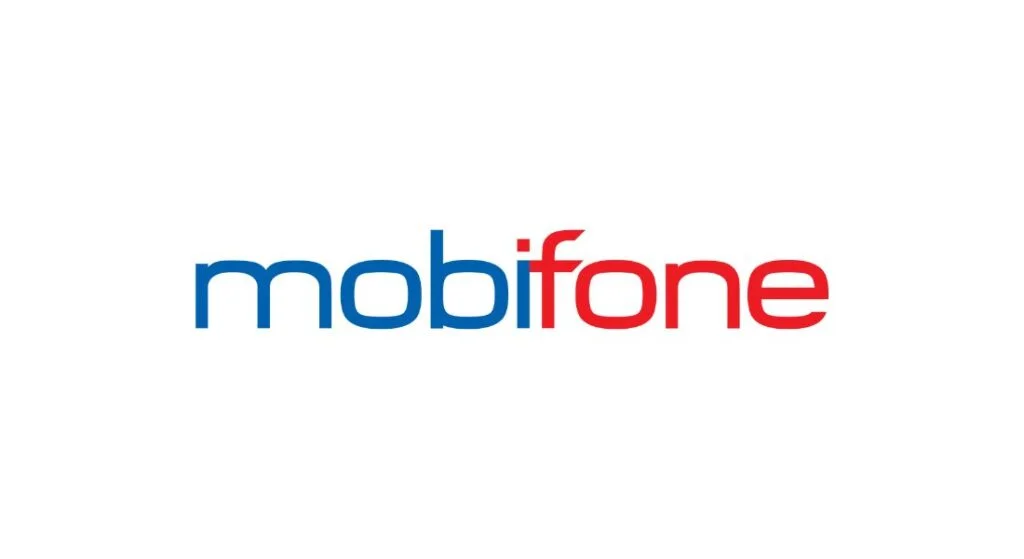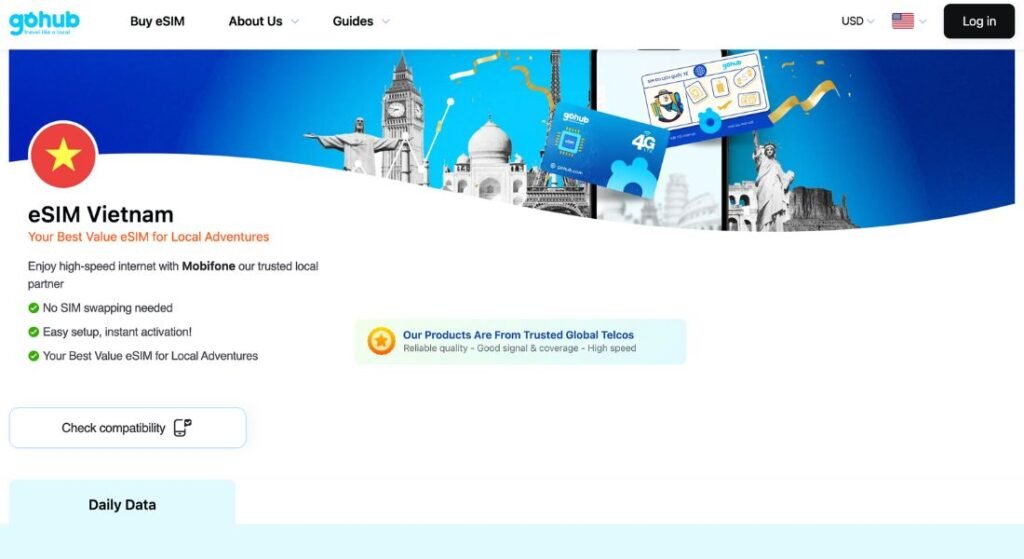You’ve just landed in Vietnam. Your eyes are still adjusting from the plane lights, your phone’s on airplane mode, and you’re standing in the arrivals hall trying to figure out how to book a Grab, message your homestay host, or translate a street sign. But wait—you still don’t have internet.
If you’ve ever been caught in this situation (or want to avoid it altogether), you’re not alone. Staying connected while traveling is no longer a luxury—it’s a lifeline. Whether you’re navigating Hanoi’s chaotic old quarter, live-streaming your bánh mì taste test in HCMC, or hopping a train through the misty hills of Sapa, having reliable, instant internet makes everything smoother.
Vietnam offers several mobile data options, and one of the top local providers is MobiFone, a popular mobile network provider known for its widespread coverage. But as a traveler, is it your best bet? Or is there an easier, smarter way to get online?
Let’s break it down—how MobiFone eSIMs work for tourists, and why more travelers are choosing Gohub for a seamless, no-fuss Vietnam connection.

I. Overview of MobiFone – What You Should Know as a Traveler
If you’ve been Googling how to stay connected in Vietnam, chances are you’ve come across MobiFone—one of the country’s biggest mobile network operators. It’s kind of a household name here, especially among locals.
Quick Facts about MobiFone:
- Founded: 1993 (one of the oldest players in the game)
- Full name: Mobile Phone Corporation
- Services: Mobile data, calls, SMS, and value-added services (2G, 3G, 4G/LTE)
- Subscriber base: Over 60 million users (yep, it’s massive)
- Coverage: Nationwide—strongest in big cities, but stretches into rural areas too
- Customer service: Available in Vietnamese and basic English via stores, hotline, app, and social media
With over 3,000 physical stores and dealerships, MobiFone is pretty much everywhere. That’s great if you want to walk into a shop and talk to a human—but as we’ll see later, that might not be the most convenient option for travelers just landing in a new country.
MobiFone is a solid local choice—but “local” is the key word. It’s designed primarily for Vietnamese residents, which means its setup process and user experience may feel clunky or confusing if you’re not fluent in the language or familiar with local systems.

II. How Good Is MobiFone’s Coverage and Speed in Vietnam?
Here’s the good news: MobiFone has solid coverage across Vietnam. Whether you’re sipping egg coffee in a Ho Chi Minh City café or trekking through the rice terraces of Sapa, chances are you’ll find a signal.
📶 What You Can Expect:
- 4G/LTE in big cities like Hanoi, Da Nang, and HCMC: Speeds can reach 40–45 Mbps, which is fast enough for video calls, YouTube, and uploading your pho pics in seconds.
- 3G in smaller towns and some rural areas: Usable for browsing, maps, and messaging, but don’t expect buttery-smooth video streaming.
- 2G or spotty coverage in remote mountain regions: It’s patchy and sometimes non-existent—great time to unplug or carry a backup plan.
MobiFone has invested heavily in infrastructure and covers 90%+ of the population, which sounds great on paper. But the experience can vary based on where you are—and whether your SIM or eSIM is set up correctly before hitting the road.
🔌 Pro Tip: If you’re planning to rely on mobile data for Google Maps, Grab, or Zoom calls, make sure your plan is preloaded and activated—network isn’t the problem, setup usually is.
Confused about roaming vs eSIM? Learn the difference and why roaming can cost you.
III. Can You Get a MobiFone eSIM in Vietnam?
The Short Answer: Yes. But it’s not exactly traveler-friendly.
MobiFone does support eSIMs—you can get one if your phone is compatible. And once it’s set up, it works just like a regular SIM card. So why doesn’t every tourist just go this route?
Because getting a MobiFone eSIM is not as seamless as it sounds.
What’s the Process Like?
To activate a MobiFone eSIM, you usually need to:
- Visit a physical store or airport kiosk
- Show your passport for registration
- Wait for a rep to process and install the profile (if the app is even working)
Some travelers report being able to get an eSIM through the MobiFone app or website—but honestly, the system is hit-or-miss. Maintenance issues, untranslated interfaces, and inconsistent service make it feel more like a quest than a quick win.
Good to Know: While it is possible to grab a MobiFone eSIM, it’s much easier if you’re already in Vietnam, speak a bit of Vietnamese, and have time to spare. Otherwise, it’s a bit of a detour.
Why Travelers Look for MobiFone Alternatives
While MobiFone eSIMs offer the technical benefits of eSIM (no plastic, no swapping, secure), the onboarding process isn’t built for international travelers who just want to land and go.
That’s why many travelers turn to dedicated eSIM services like Gohub—designed to remove the friction and let you connect instantly, before you even step off the plane.
IV. How Tourists Can Get a MobiFone SIM or eSIM in Vietnam
So, you’ve decided to try MobiFone. Here’s how to get connected—but fair warning, it might not be as instant as you’d hope.
Where to Buy a MobiFone SIM Card
This is the traditional route, and while it works, it comes with the usual travel-time friction. Here’s where you can pick one up:
- At the airport: MobiFone counters are available at major airports like Tan Son Nhat (SGN) and Noi Bai (HAN). Be prepared for lines, limited English, and variable pricing.
- Official stores in cities: Look for MobiFone shops in big cities—staff may speak basic English, and you’ll need your passport for registration.
- Hotel lobbies, convenience stores, or tour agencies: Some offer prepaid tourist SIMs, but stock and pricing can be inconsistent.
- Supermarkets & tech stores: More common in urban centers, and may still require ID.
🔍 Heads-up: You’ll need to go through a short activation process. Staff might help, but don’t count on it being instant or in English.
Where to Buy MobiFone eSIM for Vietnam
Yes, it’s technically possible—but it’s not the simplest option, especially if you’re arriving tired and just want to get online fast.
Here are your eSIM options:
- At a MobiFone store or airport kiosk: The safest bet for tourists, but requires a passport and sometimes a local phone number for verification.
- Online via the MobiFone website: Some users have success purchasing an eSIM remotely, but the interface isn’t always user-friendly—and may only work reliably in Vietnamese.
- Via travel agencies or bundles: Some local agencies offer bundled SIM/eSIM options with tour packages.
- Through reseller apps: A few third-party sites offer MobiFone eSIMs, but you’ll want to double-check reviews and refund policies.
💬 TL;DR for Travelers:
- 🛂 You’ll always need a passport to register.
- 🕒 Expect some delays or confusion if you don’t speak Vietnamese.
- 📶 It works, but setup isn’t exactly plug-and-play.
That’s why more travelers are turning to plug-and-play options like Gohub—no lines, no registration, no surprises. Just scan your QR code and connect.
V. MobiFone Plans & Pricing for Tourists – What’s the Best Deal?
MobiFone offers a wide range of prepaid packages for tourists—and if you’re staying a few weeks and don’t mind a store visit, some of the plans are pretty generous for the price.
Here’s a quick breakdown of what’s out there:
💰 Sample MobiFone Plans for Tourists
| Plan Name | Price (VND / USD) | Data | Validity | Notes |
|---|---|---|---|---|
| MFV250 | 250,000 VND (~$10.16) | 250 GB | 30 days | Best for heavy streamers or hotspot use |
| MFY | 200,000 VND (~$8.13) | 200 GB | 30 days | Great balance for most travelers |
| V180 | 180,000 VND (~$7.31) | 240 GB | 30 days | Often recommended for tourists |
| V90 | 90,000 VND (~$3.66) | 30 GB | 30 days | Budget-friendly for light users |
| MBF30 | 30,000 VND (~$1.22) | 30 GB | 7 days | Short trips or weekend getaways |
| D10 / BF30 | 10,000 VND (~$0.41) | 8 GB | 1 day | For emergencies or ultra-short stays |
eSIM-Specific Packages (Sample)
Some stores or resellers also offer:
- 6GB for 30 days (~$9.20 USD)
Often bundled with:- 60 local minutes
- 30 international minutes
- 100 SMS (local)
These plans are reasonable, but availability can vary, and setup often depends on the store you visit.
How to Top-up MobiFone SIM card/eSIM
Need more data? It’s possible, but again—not exactly instant:
- Use the MobiFone App (if you can navigate it)
- Buy a top-up card at convenience stores
- Visit a MobiFone store with cash or card
Top-ups start from as little as 15,000 VND (~$0.65) for 1 GB valid for 7 days.
So, Is It Worth It?
If you’re comfortable navigating stores, apps in Vietnamese, and local activation steps, MobiFone’s plans can offer great value for heavy data use.
But for many travelers, the time and hassle of registration, plan hunting, and manual setup outweigh the savings.
That’s where Gohub comes in—with easy-to-understand plans, instant eSIM delivery, and no surprise top-up trips in the middle of your street food tour.
VI. What Are the Alternatives to MobiFone?
While MobiFone is one of the big names in Vietnam’s mobile scene, it’s far from your only option. There are two other major players in the country—plus a growing number of digital-first eSIM providers.
Let’s break it down:
Local Network Providers
Vietnam has three main mobile carriers that offer tourist SIM and eSIM services:
1. Viettel – The Largest and Most Widely Covered
- Known for top-notch coverage—even in rural and mountainous areas
- Offers SIM cards, pocket WiFi, and eSIMs
- Sample plan: 5GB for 60 days at around 2.20 EUR (~$2.40 USD)
- Setup still requires in-person registration and some Vietnamese language support
2. Vinaphone – Popular, Especially in Southern Vietnam
- Also offers solid coverage and decent 4G speed
- Tourist SIM plans with unlimited data for 7 days at
7.30 EUR ($8 USD) - Available at airports and Vinaphone stores—again, passport required
Bottom line: Viettel, Vinaphone, and MobiFone all offer good service once you’re set up. But for tourists, they all involve a similar pain point—language barriers, physical stores, and a lot of small steps just to get online.
Global & Online eSIM Providers
If you’re looking for instant setup, English support, and no paperwork, a digital-first provider might be the better fit. Here are some options:
3. Airalo / Saily / Nomad
These global eSIM marketplaces offer Vietnam data plans, usually starting from $5–$10. They’re easy to install, but:
- Often more expensive per GB than local options
- Minimal to no refund support
- Limited customer service if something goes wrong
4. Gohub – Built for Travelers, Not Telecom Engineers
Unlike generic eSIM apps, Gohub focuses only on travelers. You get:
- ✅ Preloaded Vietnam eSIM plans
- ✅ Easy online purchase + instant QR activation
- ✅ 24/7 multilingual support (with real humans!)
- ✅ 100% money-back guarantee if something doesn’t work
- ✅ And yes… cheaper than Airalo in most cases 😉
TL;DR – Why Gohub is the best eSIM for Vietnam:
This table compares the top connectivity choices by what really matters when you’re traveling: ease, support, and setup speed. Spoiler alert—Gohub wins on all fronts.
| Provider | Coverage | Setup | Support | Ease for Tourists |
|---|---|---|---|---|
| MobiFone | Strong in cities | In-store, passport | Limited English | 😬 Medium |
| Viettel | Best nationwide | In-store, passport | Limited English | 😬 Medium |
| Vinaphone | Great in south | In-store, passport | Some English | 😬 Medium |
| Airalo/Saily | Varies | App-based | Minimal | 😐 Okay |
| Gohub | Local partner networks | Instant, no ID | 24/7 human support | ✅ Excellent |
VII. Why Gohub is the Best eSIM for Vietnam
So by now, you’ve seen the options.
Yes, you can get a local SIM in Vietnam. You can stand in airport queues, hand over your passport, hope someone speaks English, and cross your fingers the activation works.
Or… you can skip all that and start your adventure the moment you land.

Meet Gohub – Built for Modern Travelers
At Gohub, we get it—you didn’t fly halfway across the world to hunt down a SIM card. You came to get lost in Hanoi’s street food alleys, cruise through Ha Long Bay, and dance your heart out in Da Nang. You need connection, not complication.
That’s exactly why we created Gohub.
Founded in 2018, Gohub is a travel-first eSIM service trusted by over 500,000+ globetrotters. Whether you’re backpacking solo or on a work trip, our mission is simple:
Get you connected instantly—with unbeatable value, zero stress, and actual human support when you need it.
Why Travelers Love Gohub
Here’s what sets us apart from the telecom chaos:
| 🌍 Feature | ✅ Gohub Advantage |
|---|---|
| Instant eSIM delivery | Get your QR code by email—no lines, no stores |
| No passport registration | Buy online from home, activate before you fly |
| Wide plan variety | Data-only or with calls, for short trips or long hauls |
| Local network partners | Same 4G/5G speed as the major Vietnamese carriers |
| 24/7 multilingual support | Real humans, not bots. Always here for you. |
| 100% refund guarantee | If it doesn’t work, you don’t pay. Simple as that. |
Bonus: We don’t just sell you data—we share real local tips, insider blogs, and cultural nuggets to help you go beyond Google Maps.
The Gohub Difference? Peace of Mind.
When you choose Gohub, you’re not just buying a data plan—you’re choosing to travel smarter, lighter, and more confidently.
No stress. No roaming shocks. No SIM-swapping drama in a Grab car. Just tap, scan, and go.
I installed my Gohub eSIM while boarding my flight. Landed in Hanoi, turned on my phone—and bam, instant connection. So easy.
Claire M., solo traveler from Melbourne
Ready to Get Connected?
Skip the chaos. Join the 500,000+ travelers who trust Gohub for fast, easy, and affordable eSIMs in Vietnam and 100+ countries.
👉 Explore Vietnam eSIM Plans Now
VIII. Smart Tips for Using Mobile Data in Vietnam
No matter which provider you go with—MobiFone, Viettel, Vinaphone, or Gohub—here are some essential tips to help you get the most out of your mobile data while exploring Vietnam:
1. Make Sure Your Phone Supports eSIM
If you’re going the eSIM route (like with Gohub), double-check that your device is compatible. Most smartphones from 2020 onward are good to go.
- iPhone XS and later, Pixel 3 and up, Samsung Galaxy S20+ usually support eSIM.
- Tip: Just Google “[Your Phone Model] + eSIM compatibility.”
2. Track Your Data Usage
You don’t want to burn through your plan streaming TikToks in your hotel. Set a daily data limit or monitor usage in your phone settings.
- Pro Tip: Restrict background data for apps like Instagram or cloud storage that eat up gigs fast.
3. Stick to Messaging Apps
Apps like WhatsApp, Zalo, Telegram, or Messenger are perfect for calls and messages.
They’re way cheaper than international SMS—and more reliable too.
4. Use Public Wi-Fi Wisely
Free Wi-Fi is everywhere—cafés, hostels, airports—but not all networks are secure.
Always use a VPN if you’re doing anything sensitive like banking or logging into important accounts.
5. eSIM Activation Tips
- If using Gohub: You’ll get a QR code via email—just scan it in your phone’s settings, and boom, you’re connected.
- If using local eSIMs: You may need to register with a passport or go through a Vietnamese-language app. Plan for 30–60 mins setup time.
6. Bring a Power Bank!
Maps, Google Translate, and constant uploads = battery drain. Vietnam is photo heaven, so you’ll want to stay juiced up.
Final Tip? Choose a SIM That Matches How You Travel
If you’re the type who wants everything sorted before you land, go for an eSIM like Gohub. If you love winging it and don’t mind a language challenge, a local SIM might be part of the adventure.
Either way, stay connected and stay curious—Vietnam’s magic unfolds best when you’re free to explore (with GPS working, of course ).
IX. Conclusion – MobiFone eSIM or a Smarter Alternative?
Yes, MobiFone eSIM works in Vietnam—but it often requires in-person registration, passport checks, and some guesswork.
If you’d rather skip the hassle, activate before you land, and enjoy instant, reliable data with real support, Gohub is the better choice.








